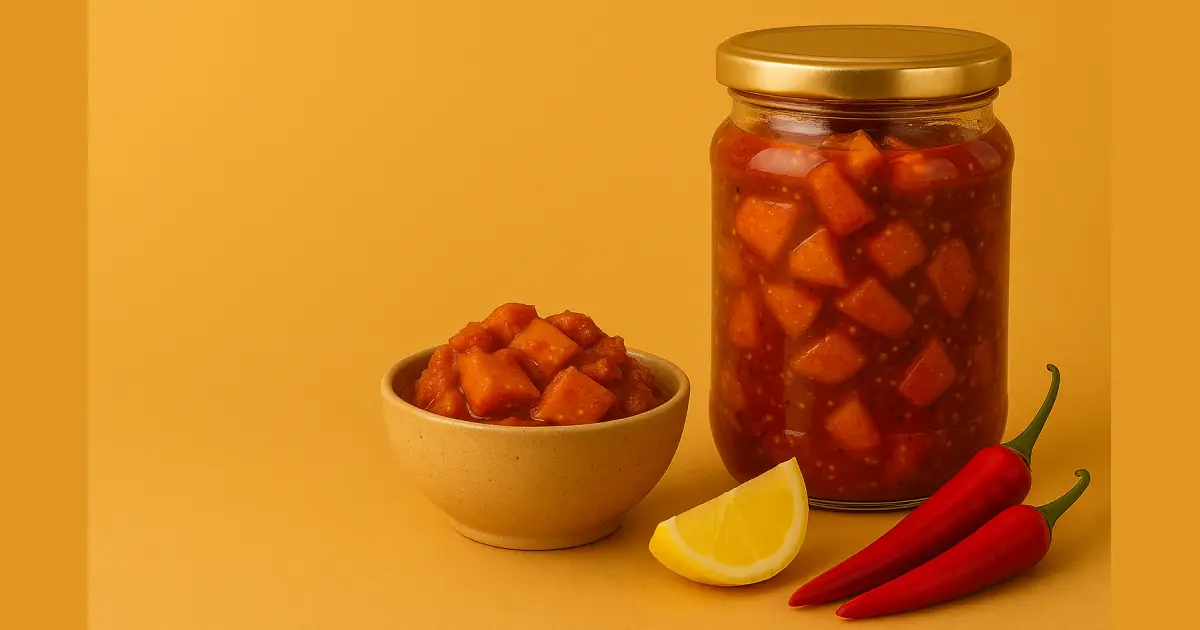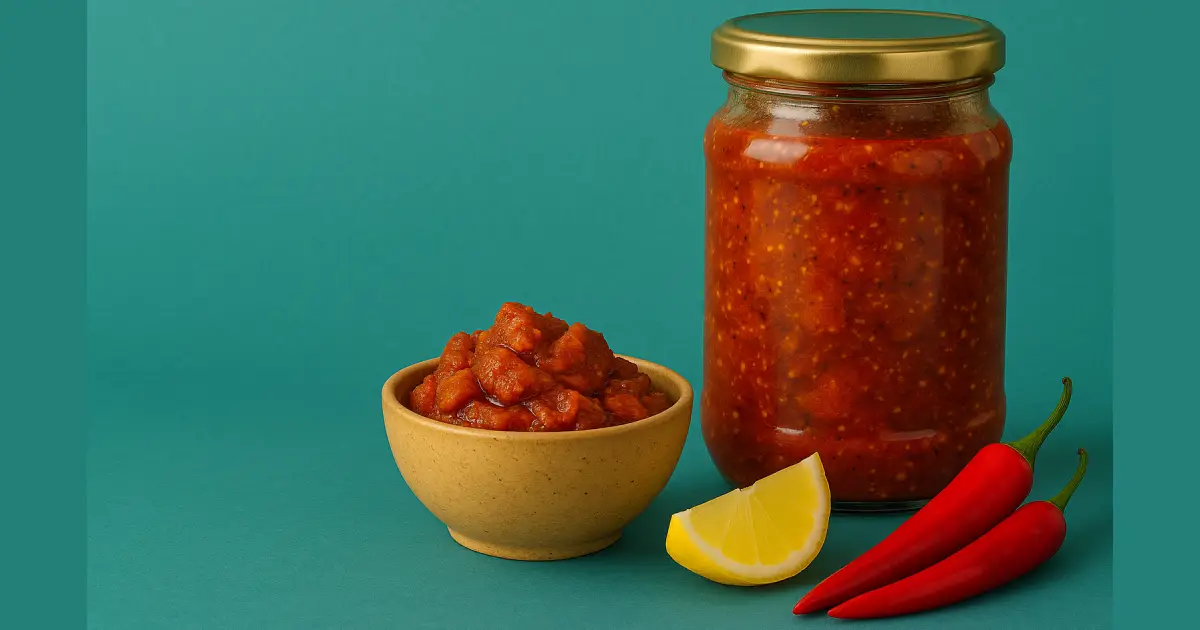- Your cart is empty
- Continue Shopping

The Psychology of Achar Cravings: Why Spicy-Sour Comforts Us
Achar—pickle in the Indian tradition—isn’t just food. It’s a small jar of memory, culture, and emotion, waiting to explode on the tongue. From the sting of mustard oil to the tang of lime, the heat of chili to the mellow depth of aging, achar is an experience that goes beyond taste. Many people wonder why a spoonful of spicy-sour pickle can lift the mood, calm anxiety, or spark nostalgia. The answer lies at the crossroads of psychology, neuroscience, and culture.
The Flavor Puzzle: Sour, Spicy, and the Brain.
The human palate is wired to react strongly to sour and spicy flavors. Sourness is a signal of fermentation, often tied to preservation, while spiciness triggers the body’s pain receptors. When we eat something spicy, our body responds with a mild stress signal, releasing endorphins—natural painkillers that create a rush of pleasure. This is the same reason why thrill-seekers enjoy roller coasters: the danger is simulated, not real, and the “safe pain” gives a euphoric kick.
Sourness, meanwhile, is closely tied to freshness, acidity, and the body’s survival instinct. In evolutionary terms, a sour taste once warned us of unripe fruit or spoiled food. Over time, humans learned to embrace controlled sourness through pickling and fermentation. Achar carries this dual punch—heat and tang—that excites the nervous system while reassuring the mind that the food is safe, flavorful, and deeply satisfying.
Comfort in Nostalgia of Achar.
Beyond chemistry, cravings for achar are drenched in memory. For many, achar is first encountered at home: a grandmother’s jar of mango pickle aging on the terrace, or the smell of lemon achar wafting from a clay pot in summer. Each bite can trigger powerful nostalgia, tapping into what psychologists call “autobiographical memory”—the recall of lived, emotional experiences.
Studies show that nostalgic foods can lower stress, increase feelings of belonging, and even reduce loneliness. When life feels uncertain, turning to achar is like reaching for a familiar voice in the crowd. Its taste is not just sharp and spicy; it’s also a time machine that connects us with people, places, and rituals of the past.
Spicy-Sour as Stress Relief.
Modern life is filled with stress, and food often doubles as coping. Spicy and sour foods have unique psychological effects in stress relief. Spicy flavors, by stimulating the release of endorphins, mimic a “runner’s high.” Sour flavors activate salivation and digestion, creating a physical sensation of refreshment. Together, they provide both stimulation and relief—a paradox that the brain finds rewarding.
This explains why achar often shows up as a sidekick to bland meals like dal-rice or khichdi. The main dish is comforting in its plainness, while the pickle delivers a sensory punch, jolting the mind into alertness and balance. In psychological terms, achar is both the blanket and the firecracker at the dinner table.
Cultural Conditioning: Why We Crave Achar What We Grew Up With.
The craving for achar is also cultural conditioning at its finest. In India, almost every region has its own pickle tradition: fiery red chilies from Rajasthan, mustard-rich mango pickle from Uttar Pradesh, lemon achar from South India, fish and bamboo shoot pickles from the Northeast. These aren’t just recipes; they are cultural imprints passed through generations.
Psychologists call this “flavor-nation imprinting”—the way our taste preferences are formed by early exposure. For someone raised in India, the salty-oily punch of achar feels normal, even necessary. For someone from another part of the world, the same jar might taste overwhelming. Our cravings are shaped as much by memory and culture as they are by biology.

The Ritual of Control and Preservation.
Achar also represents control over chaos. At its core, pickling is the act of preserving perishable fruits or vegetables against time and decay. In psychological terms, this act of preservation creates a sense of security. Having jars of achar in the pantry reassures us that flavors and nourishment are within reach, even when fresh produce isn’t.
On a symbolic level, achar is an antidote to impermanence. It lets us capture the heat of summer mangoes, the freshness of winter carrots, or the zing of lemons, preserving them for months or years. This plays into a deeper human need: to hold onto moments, extend pleasure, and resist loss. Every bite, therefore, feels like victory over transience.
The Social Side of Cravings.
Food isn’t eaten in isolation—it’s shared. Achar is often placed in the center of the table, a communal offering that everyone dips into. This social dimension heightens its comfort factor. Psychologists emphasize that food sharing builds bonds and reinforces group identity. When we crave achar, we may also be craving connection, family rituals, and the warmth of community.
Even in diaspora communities, achar jars often travel across continents, smuggled lovingly in suitcases or mailed in bubble wrap. The craving becomes not only about taste but also about belonging. It’s a way of carrying home across oceans.
Why Achar Cravings Resurface in Emotional Lows.
Finally, achar cravings often resurface during emotional lows—when people feel tired, sad, or lonely. Cravings aren’t just about hunger; they are about seeking regulation. The sharp, fiery hit of achar shocks the system, waking up the senses, while the cultural memory attached to it reassures the heart. It’s a dual effect: stimulation plus comfort.
This is why achar is more than “just a side dish.” It’s a psychological tool, a flavor ritual, and sometimes even a silent therapist on the plate.
The psychology of achar cravings reveals a fascinating interplay of biology, memory, and culture. The spicy-sour notes excite the nervous system, trigger endorphins, and refresh the body. Nostalgia and cultural imprinting make the taste emotionally grounding. And the act of preservation and sharing adds layers of symbolic comfort.
To crave achar is to crave intensity and reassurance at once. It’s the paradox of life—heat and calm, sourness and sweetness, present and past—captured in a single spoonful. Far from being a mere condiment, achar is living proof that our tongues, hearts, and memories are bound together in jars of oil and spice.
Read This Now – India: The True Motherland of Achar.

1 Comment